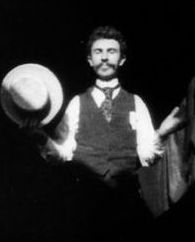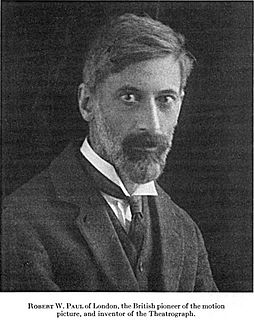
The Lumière brothers, Auguste Marie Louis Nicolas Lumière and Louis Jean Lumière, were manufacturers of photography equipment, best known for their Cinématographe motion picture system and the short films they produced between 1895 and 1905.

William Kennedy-Laurie Dickson was a Scottish inventor who devised an early motion picture camera under the employment of Thomas Edison.

A movie theater, cinema, or cinema hall, also known as a picture house, the pictures, picture theatre, or the movies, is a building that contains auditoria for viewing films for entertainment. Most, but not all, theaters are commercial operations catering to the general public, who attend by purchasing a ticket. Some movie theaters, however, are operated by non-profit organizations or societies that charge members a membership fee to view films.
The following is an overview of the events of 1896 in film, including a list of films released and notable births.
Thomas J. Armat was an American mechanic and inventor, a pioneer of cinema best known through the co-invention of the Edison Vitascope.

Oskar Messter was a German inventor and film tycoon in the early years of cinema. His firm Messter Film was one of the dominant German producers before the rise of UFA, into which it was ultimately merged.

Birt Acres was an American and British photographer and film pioneer. Among his contributions to the early film industry are the first working 35 mm camera in Britain (Wales), and Birtac, the first daylight loading home movie camera and projector. He also directed a number of early silent films.

Robert William Paul was an English pioneer of film and scientific instrument maker.

Max Skladanowsky was a German inventor and early filmmaker. Along with his brother Emil, he invented the Bioscop, an early movie projector the Skladanowsky brothers used to display the first moving picture show to a paying audience on 1 November 1895, shortly before the public debut of the Lumière Brothers' Cinématographe in Paris on 28 December 1895.

David Devant was an English magician, shadowgraphist and film exhibitor. He was born David Wighton in Holloway, London. He is regarded by magicians as a consummate exponent of suave and witty presentation of stage illusion. According to magic historian Jim Steinmeyer, Devant was “England’s greatest magician—arguably the greatest magician of the 20th Century”.

Cinéorama was an early film experiment and amusement ride presented for the first time at the 1900 Paris Exposition. It was invented by Raoul Grimoin-Sanson and it simulated a ride in a hot air balloon over Paris. It represented a union of the earlier technology of panoramic paintings and the recently invented technology of cinema. It worked by means of a circulatory screen that projects images helped by ten synchronized projectors.
The decade of the 1890s in film involved some significant events.
Events from the year 1896 in the United Kingdom.

Carl Hertz was an American magician.

The history of film technology traces the development of techniques for the recording, construction and presentation of motion pictures. When the film medium came about in the 19th century, there already was a centuries old tradition of screening moving images through shadow play and the magic lantern that were very popular with audiences in many parts of the world. Especially the magic lantern influenced much of the projection technology, exhibition practices and cultural implementation of film. Between 1825 and 1840, the relevant technologies of stroboscopic animation, photography and stereoscopy were introduced. For much of the rest of the century, many engineers and inventors tried to combine all these new technologies and the much older technique of projection to create a complete illusion or a complete documentation of reality. Colour photography was usually included in these ambitions and the introduction of the phonograph in 1877 seemed to promise the addition of synchronized sound recordings. Between 1887 to 1894, the first successful short cinematographic presentations were established. The biggest popular breakthrough of the technology came in 1895 with the first projected movies that lasted longer than 10 seconds. During the first years after this breakthrough, most motion pictures lasted about 50 seconds, lacked synchronized sound and natural colour, and were mainly exhibited as novelty attractions. In the first decades of the 20th century, movies grew much longer and the medium quickly developed into one of the most important tools of communication and entertainment. The breakthrough of synchronized sound occurred at the end of the 1920s and that of full color motion picture film in the 1930s. By the start of the 21st century, physical film stock was being replaced with digital film technologies at both ends of the production chain by digital image sensors and projectors.

Manuel Trujillo Durán was a Venezuelan photographer who pioneered film in Venezuela. Trujillo was most successful as a photographer, though he dabbled in other industries and is best remembered for his connections to the fledgling film industry in Venezuela. He became one of the first people from Latin America to learn how to show films; he was thought for many years to be the director of Venezuela's first films, and traveled through Venezuela and Colombia with projectors to introduce cinema to this part of the South American continent.
Venezuela was introduced to cinema as a for-profit industry in the 1890s, when the medium became international. There were at least eight national films made in the decade, by three groups of filmmakers — one of the groups was based in Maracaibo and one was based in Caracas. The first film screening in the nation may have taken place as early as 1894, but is generally reported as 1896, with this later date being the first scheduled public screening.
Cinema of Zambia refers to the cinema and film industry of the country of Zambia.
Venezuela had been introduced to cinema in the 1890s. After an initial boom in screenings and production, the presence of cinema in the nation was lower between 1900 and 1910.












